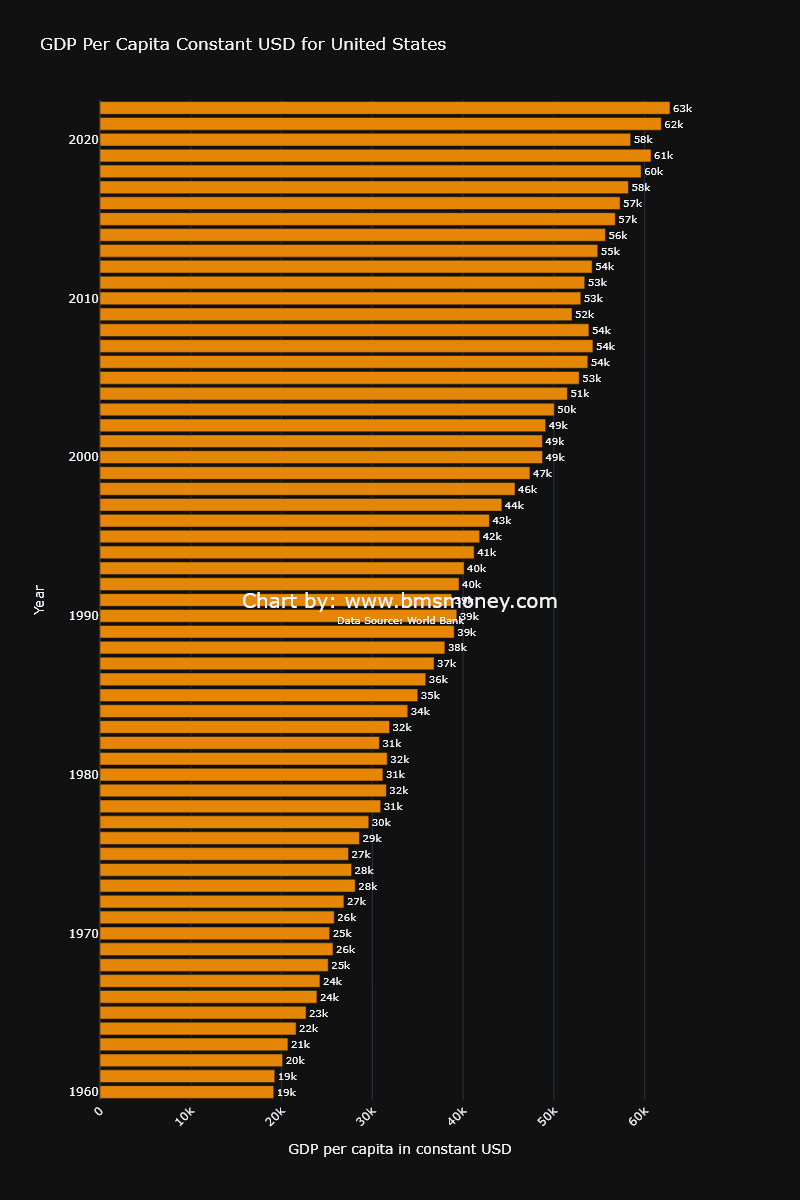- 1960s: GDP per capita up from $19k to $27k, driven by post-war growth.
- 1970s: Gradual rise to $31k despite stagflation and oil crises.
- 1980s: Reaganomics boosts GDP per capita from $31k to $38k.
- 1990s: Tech boom increases GDP per capita to $46k.
- 2000s-2010s: Resilience and recovery, GDP per capita reaches $63k by 2019.

Introduction
Gross Domestic Product (GDP) per capita is a key indicator used to gauge the economic performance of a country. It provides an average economic output per person and is often used as a measure of living standards. The data depicted in the provided chart showcases the GDP per capita in constant USD for the United States from 1960 to 2020. This analysis aims to break down the trends, significant changes, and economic events that influenced these figures over the 60-year period.
Decade-by-Decade Breakdown
1960s: Economic Expansion
The 1960s was a period of significant economic growth in the United States, driven by post-war industrialization and consumer spending. The GDP per capita in 1960 was approximately $19,000. By the end of the decade, it had risen to around $27,000. This growth can be attributed to increased productivity, technological advancements, and government investments in infrastructure and education.
1970s: Stagflation and Economic Challenges
The 1970s were marked by economic turmoil, including the oil crises of 1973 and 1979, which led to high inflation and unemployment – a phenomenon known as stagflation. Despite these challenges, the GDP per capita saw a gradual increase from $27,000 in 1970 to $31,000 in 1979. This decade's slower growth reflects the economic difficulties of the time.
1980s: Reaganomics and Recovery
The 1980s began with a recession but saw a robust recovery due to significant tax cuts, deregulation, and increased defense spending under President Ronald Reagan's economic policies, commonly referred to as Reaganomics. The GDP per capita grew from $31,000 in 1980 to $38,000 by 1989. This period also saw the rise of new industries, particularly in technology and finance, contributing to economic growth.
1990s: Technology Boom
The 1990s were characterized by a remarkable economic boom driven largely by technological advancements, particularly the rise of the internet and the information technology sector. The GDP per capita rose from $39,000 in 1990 to $46,000 by 1999. This decade's growth was also supported by a stable inflation rate, low unemployment, and increased global trade.
2000s: Dot-Com Bust and Financial Crisis
The early 2000s faced economic challenges beginning with the burst of the dot-com bubble around 2000-2001, followed by the significant impact of the 2008 financial crisis. Despite these setbacks, the GDP per capita increased from $46,000 in 2000 to $49,000 in 2009. The resilience of the economy during these periods can be attributed to policy responses and the inherent strength of the US economic system.
2010s: Recovery and Growth
Following the financial crisis, the 2010s marked a decade of recovery and growth. GDP per capita grew from $49,000 in 2010 to $63,000 in 2019, indicating a strong economic recovery. Key factors included monetary stimulus from the Federal Reserve, technological advancements, and a stable global economic environment. The end of the decade saw GDP per capita reaching its highest levels in this 60-year span.
Top Performing Funds for You
Top Performing Equity Funds Top Performing Debt Funds Top Performing Hybrid FundsKey Economic Events and Policies
Oil Crises of the 1970s
The oil embargoes of 1973 and 1979 had a significant impact on the US economy, leading to high inflation and unemployment. These events highlighted the vulnerabilities in the US economy's dependence on oil and resulted in a push for energy conservation and alternative energy sources.
Reaganomics
The economic policies of the 1980s under President Reagan aimed to stimulate economic growth through supply-side measures, including tax cuts, deregulation, and increased defense spending. These policies contributed to a period of significant economic expansion and technological innovation.
Dot-Com Bubble
The late 1990s and early 2000s saw a rapid rise in internet-based companies, which led to speculative investments and an eventual market crash around 2000-2001. This period was followed by a brief recession but also laid the groundwork for future technological advancements.
2008 Financial Crisis
The global financial crisis of 2008 had a profound impact on the US economy, leading to severe recession and a significant drop in GDP. The government's response included large-scale stimulus packages and monetary easing, which helped stabilize and eventually recover the economy.
Technological Advancements
Throughout the decades, technological innovation has been a critical driver of economic growth in the United States. The IT revolution in the 1990s, the rise of the internet, and continuous advancements in various sectors have consistently contributed to increasing GDP per capita.
Top Performing Equity Fund Categories for You
Top Performing Large Cap Funds Top Performing Mid Cap Funds Top Performing Small Cap FundsConclusion
The GDP per capita in the United States has shown a consistent upward trend from 1960 to 2020, reflecting the country's economic growth and resilience. Each decade brought unique challenges and opportunities, shaping the economic landscape in distinct ways. From post-war expansion and the oil crises to technological booms and financial crises, the US economy has navigated numerous hurdles to achieve significant growth in GDP per capita. Understanding these trends provides valuable insights into the factors that drive economic performance and the importance of policy responses in managing economic challenges.